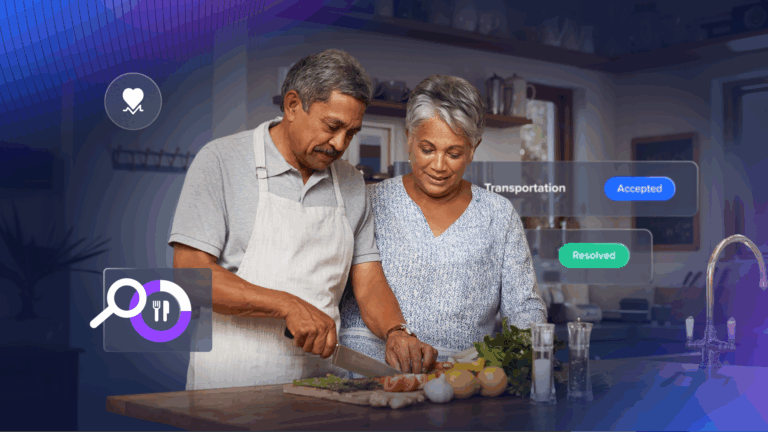
The Foundational First Step in Achieving Quality Care: Assessing and Addressing the Diverse Spectrum of Social Care Needs
Written by Halima Ahmadi-Montecalvo, PhD, MPH, Unite Us; Leigh Caswell, MPH, Presbyterian Healthcare Services; Gillian Feldmeth, BS, Unite Us; Amanda Terry, PhD, MPH, MA, Unite Us; Adrianna Nava, PhD, RN, NCQA; Antoinette Grinstead, MPA, Presbyterian Healthcare Services
Introduction
It is well documented that social drivers of health (SDOH) contribute to a person’s health, well-being, and quality of life and that unmet social needs contribute to health disparities, especially among vulnerable populations. The healthcare industry and regulatory environment continue to advance value-based payment models, with increasing emphasis on primary and longitudinal services to address chronic and communicable diseases and their associated healthcare costs, in an effort to improve health equity.
Given the substantial evidence base tying unmet social needs (e.g., food, housing, transportation, social connection) to poorer health outcomes and higher healthcare costs, it is no surprise that the shift to quality care has ushered forth renewed energy across sectors to resolve those unmet needs that may be impacting health. Addressing social needs may require providers and systems to change their documentation practices and lean into community services and partnerships. Providing this type of “person-centered” quality care will require building bridges and closed-loop infrastructure between the health and social sectors to allow for seamless patient referrals, social care navigation, documentation of outcomes, and reimbursement.
In this article, we review the current literature pertaining to social care and quality outcomes, provide a case example, and follow up with recommendations for assessing and addressing the diverse spectrum of social care needs. We believe that by adopting this approach to inclusive health care and de-siloing health and social services, we move toward true quality care. When we do this at scale, quality care will become equitable care and equitable care, quality care.
Healthcare Stakeholders Recognize the Role of Social Drivers of Health (SDOH)
Before social needs can be addressed, they must first be assessed. National organizations such as the National Committee for Quality Assurance (NCQA), Joint Commission, National Quality Forum (NQF), American Hospital Association and at least 28 states recommend or require social need screening, with 17 states requiring uniform SDOH questions within screening tools. Social need measures are currently included or proposed to be included in at least 18 CMS programs, initiatives, or federal guidance. Beginning in 2024, the Centers for Medicare and Medicaid Services (CMS) will require hospitals reporting to the Inpatient Quality Reporting program to submit two brand new measures: SDOH-1 (Of all the patients admitted to the hospital, how many were screened for SDOH?) and SDOH-2 (How many were identified as having one or more social risk factor?).
In advance of specific recommendations and regulations, healthcare stakeholders have already recognized that implementation of interventions to identify and address SDOH is one mechanism to improve the quality of care and deliver better outcomes. From 2017 to 2019, fifty-seven health systems in the U.S. publicly announced investments of approximately $2.5 billion toward addressing SDOH including housing, food security, and job training. Additionally, analysis of a 2021 national hospital survey demonstrated that more than 75% of acute care hospitals already screen for health-related social needs.
Health plans too are recognizing the importance of addressing SDOH by working to expand information exchange and establishing partnerships with community-based organizations (CBOs), especially in light of recent Medicare Advantage policy changes (i.e., supplemental benefits that are not primarily health-related). For example, from 2023-2023, Horizon Blue Cross Blue Shield of New Jersey operated one of the largest programs, Horizon Neighbors in Health, to address SDOH in the state of New Jersey. The Neighbors in Health program utilized community health workers and personal health assistants to improve the health and well-being of individuals across 21 counties. By the summer of 2023, the program had enrolled over 13,000 members and had met the social needs of 8,000 individuals. The success of the program led Horizon to integrate the approach into its larger care management program and increase screening of and engagement with members who have SDOH needs.
The Impact of Social Care on Quality Outcomes
Healthcare systems, payers, and others are understandably eager for additional rigorous evidence showing that addressing social care needs can measurably improve health outcomes and reduce unnecessary spending. While longer-term outcomes are important, quality measures such as preventive screenings, engagement with primary care, medication adherence, and satisfaction with care can serve as more proximal measures for the impact of addressing social needs. Improvements in these process measures may be a signal that social needs are being addressed.
Results from a retrospective, cross-sectional analysis of 7,995 individuals found that those with transportation vulnerability were significantly less likely to be vaccinated against influenza. A study examining the relationship between cancer screening completion and receipt of government housing assistance among low-income adults found that housing assistance facilitated increased breast cancer screening among certain subgroups (with odds of mammography completion increasing more than two-fold for Hispanic and younger women). Another cohort study of 6,692 antihypertensive medication users found that receipt of Supplemental Nutrition Assistance Program benefits was associated with a nearly 14-percentage point reduction in medication nonadherence among food-insecure patients. Importantly, interventions that help individuals address social needs (e.g., via connection to community-based resources) have been linked to improved patient satisfaction. In one national study of nonelderly Medicaid managed care enrollees, those who received social needs assistance (e.g., transportation, food, housing) rated perceived quality of care as “the best” compared to those who did not receive social needs assistance. Two other nationally representative patient satisfaction surveys indicated that patients perceived they were “better cared for” and had more trust in their provider or health system when screened for social risks.
Finally, results from the Accountable Health Communities model, which systematically tested the impact of screening and navigation interventions to resolve health-related social needs of publicly-insured individuals, show reduced emergency department visits among Medicaid and fee-for-service Medicare beneficiaries compared to matched controls. The reduction, especially for Medicare beneficiaries, was driven largely by avoidable healthcare use, suggesting social care navigation may impact beneficiary behavior that fundamentally alters the type of healthcare used. Additional insights shared directly from one model participant highlight the value of screening and referral work for both providers and patients alike, and the importance of “closing the loop” and reimbursing community partners for their important role.
Case Study: Insights from Scaling Social Needs Screening Workflows Across New Mexico
One highly successful example of a universal social needs screening program is Presbyterian Healthcare Services. In the fall of 2021, Presbyterian Healthcare Services implemented universal social needs screening to ensure all patients with a clinical encounter within the delivery system were screened at least every six months to identify social needs in the areas of food, housing, transportation, utilities, substance/alcohol/tobacco use, possible depression, and interpersonal safety. Presbyterian’s IT and Clinical Informatics teams were engaged to identify optimal workflows and leverage SDOH functionalities within its Electronic Medical Records (EMR) system. In ambulatory and inpatient settings, screening was integrated into the rooming process, while in emergency department settings it was added to the secondary triage workflow.
The project team focused on automating the screening process by configuring pop-up messages to alert rooming and triage teams when screening questions were due to be asked, and adding the questions to the eCheck-in process to give patients the option to self-screen through their patient portal. If a social need is identified during screening, an automated process initiates within the EMR and an integrated cross-sector collaboration software (Unite Us) generates a personalized list of community services delivered directly to the patient’s after-visit summary. Since the launch of universal screening, Presbyterian Healthcare Services has conducted more than 2.8 million screenings, identifying and providing community resources for more than 250,000 social needs.
While identification of social needs is a critical step, improving clinical outcomes will require acting on those social needs through SDOH interventions, including follow-up to determine if the need was resolved. As Leigh Caswell, Vice President of Community and Health Equity at Presbyterian Healthcare Services states,
“Scaling and sustaining the social care navigation infrastructure has been a challenge because we’ve learned a referral to a social service isn’t enough; there needs to be navigation through community health workers, social workers, and/or peer support specialists to community resources and follow-up to support patients through the barriers faced while navigating these systems. With innovative value-based payment models and Medicaid 1115 waivers, these types of social care navigators and social service resources are becoming more accessible and sustainable, incorporating funding for these services including direct payment for food prescription programs and reimbursement for community health workers.”
In 2024, Presbyterian will utilize a closed-loop referral system through Unite Us that will facilitate referrals directly to CBOs on behalf of Presbyterian patients, and provide visibility into the community care delivered, until an outcome or resolution is documented for the patient’s social need. Using metrics that track not only if screening occurred and if a referral was made, but also how long it takes the referral to be accepted by a partner—and ultimately the specific outcome of the referral—will enable better understanding of where additional investment is needed in the community to ensure appropriate capacity of social services to address needs.
Standardization in Social Needs Measurement: A Key to Meaningful Data
The standardization of measures involves a nuanced approach that extends from aligning data elements within specific measures, with a focus on screening and intervention terminology, to establishing a coherent standardization across the broader SDOH ecosystem. This comprehensive effort not only harmonizes the granularity of data elements needed to screen for social needs, but also addresses the need for uniform metrics across the healthcare system. To access valuable data, standardization ensures meaningful comparisons of population health outcomes, contributing significantly to the goal of reducing health disparities, especially for underserved communities. Nationally, work is being done to ensure alignment among social needs measures, with a commitment to create a unified and interoperable framework for robust analysis and informed decision-making for all stakeholders. Five fundamental domains, encompassing aspects of food insecurity, housing instability, transportation needs, utility insecurity, and interpersonal safety, have been recognized across national and state-level programs and initiatives. As the industry begins to incorporate social care data into standard practice, care should be taken to utilize standard and validated tools to evaluate impact on quality of care.
In February 2023, NCQA, the Joint Commission and NQF released a joint statement recognizing the importance of using a Fast Healthcare Interoperability Resources (FHIR)-based approach to meet the social needs of individuals in the healthcare system. The FHIR Questionnaire and Questionnaire Response profile enables the exchange of findings on standardized instruments, which can be measured and trended at the individual level. This person-reported information will be valuable for improving quality and equity at the population health level. By incorporating standardized data elements, we can more accurately compare outcomes across organizations and industries.
In Measurement Year (MY) 2023, NCQA published their Social Needs Screening and Intervention measure in the Healthcare Effectiveness Data and Information Set (HEDIS®) to assess, quantify, and evaluate the performance of social needs screening at interventions at the health plan level. NCQA’s primary emphasis has centered on tackling unmet social needs in the domains of food, housing, and transportation through the ongoing implementation of Social Needs Screening and Intervention measure, which was released in HEDIS Measurement Year (MY) 2023. First year analysis, scheduled for the summer of 2024, promises valuable insights into the effectiveness of utilizing current Logical Observation Identifiers Names and Codes (LOINC®)-based terminology for capturing social need screenings. Furthermore, this evaluation will play a pivotal role in determining the seamless integration of CMS’s recent recommendations, as outlined in the Physician Fee Schedule for 2024. This includes exploring the incorporation of additional SDOH data, such as ICD-10 Z codes, into the existing landscape of social needs measurement.
Another critical component to addressing social needs is data stratification that captures and respects the diversity of the U.S. population including race, ethnicity, language, or disability (REALD) as well as sexual orientation or gender identity (SOGI). For example, CMS recommends states implement stratification in the Medicaid Home and Community Based Services Quality Measure Set and the Hospital Readmissions Reduction Program, and NCQA required race and ethnicity stratification for 5 HEDIS measures in measurement starting in 2022. These data categories can be used to create more detailed and meaningful stratification for quality performance measurement, which must not be overlooked as we continue to understand differences in SDOH outcomes among subpopulations.
Looking Forward
We are at a pivotal moment where multiple sectors are more motivated than ever to address SDOH, eliminate healthcare disparities, and measurably improve the lives of the individuals they serve. In communities across the U.S., health systems, payers, government agencies, CBOs, and others are working more closely together to assess social needs, address identified concerns, document the outcome of assistance received, and, increasingly, provide financial reimbursement for services rendered. This cross-sector collaboration is driven, in part, by the fundamental belief that addressing health-related social needs is core to providing high-quality, equitable, and whole-person-centered care. As screening for social needs becomes even more commonplace, it is imperative that organizations proactively consider the “so what” should a need be identified. To do this effectively, we are calling for a paradigm shift that recognizes community-based services like food assistance, housing support, and transportation, as equal partners in the care continuum. We encourage early and sustained engagement of CBOs, as well as patients, in the design, implementation, and evaluation of interventions to assess and address social needs.
1HEDIS® is a registered trademark of the National Committee for Quality Assurance (NCQA).



